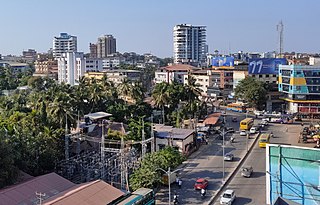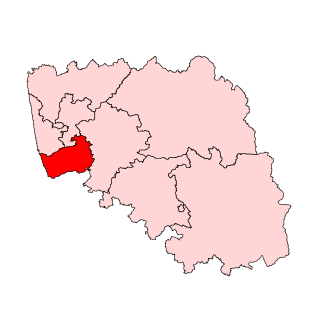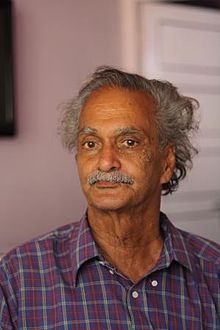
Karnataka, formerly Mysore State, is a state in the southwestern region of India. It was formed as Mysore State on 1 November 1956, with the passage of the States Reorganisation Act, and renamed Karnataka in 1973. The state was part of the Carnatic region in British terminology. Its capital and largest city is Bengaluru (Bangalore).

Tulu is a Dravidian language whose speakers are concentrated in Dakshina Kannada and in the southern part of Udupi of Karnataka in south-western India and also in the northern parts of the Kasaragod district of Kerala. The native speakers of Tulu are referred to as Tuluva or Tulu people and the geographical area is unofficially called Tulu Nadu.

Mangalore, officially known as Mangaluru, is a major port city in the Indian state of Karnataka and on the west coast of India. It is located between the Arabian Sea and the Western Ghats about 352 km (219 mi) west of Bangalore, the state capital, 20 km north of Karnataka–Kerala border, 297 km south of Goa. Mangalore is the state's only city to have all four modes of transport—air, road, rail and sea. The population of the urban agglomeration was 619,664 according to the 2011 national census of India. It is known for being one of the locations of the Indian strategic petroleum reserves.

Dakshina Kannada district is a district of Karnataka state in India, with its headquarters in the coastal city of Mangalore. It is part of the larger Tulu Nadu region. The district covers an area nestled in between the Western Ghats to its east and the Arabian Sea to its west. Dakshina Kannada receives abundant rainfall during the Indian monsoon. It is bordered by Udupi district to the north, Chikmagalur district to the northeast, Hassan district to the east, Kodagu to the southeast and Kasaragod district of Kerala to the south. According to the 2011 census of India, Dakshina Kannada district had a population of 2,083,625. It is the only district in Karnataka state to have all modes of transport like road, rail, water and air due to the presence of a major hub, Mangalore. This financial district is also known as the Cradle of Indian banking.

Tigalari, also known as Tulu script, is a Southern Brahmic script which was used to write Tulu, Kannada, and Sanskrit languages. It was primarily used for writing Vedic texts in Sanskrit. It evolved from the Grantha script. It is called as Tigalari lipi in Kannada-speaking regions and Tulu speakers call it as Tulu lipi. It bears high similarity and relationship to its sister script Malayalam, which also evolved from the Grantha script.

Udupi district is an administrative subdivision in the Karnataka state of India, with the district headquarters in the city of Udupi. It is situated in the Canara old north malabar coastal region, there are seven taluks, 233 villages and 21 towns in Udupi district. The three northern tehsils of Udupi, Kundapur and Karkala, were partitioned from Dakshina Kannada district to form Udupi district on 25 August 1997. Moodabidri was officially declared as new tehsil (taluk), separated from Karkala with effect from 11 January 2018.

The Kannada language has come a long way in the computing field starting from initial software related to desktop publishing to portals and internet applications in the current age. Kannada is the official language of the state of Karnataka in India whose capital city of Bangalore is known as the Silicon Valley of India. Kannada also entered the Wikipedia world when Kannada Wikipedia was started in September 2004.
The Rajyotsava Prashasti or Rajyotsava Awards, the second highest civilian honor of the Karnataka state of India are conferred annually by the Karnataka Government on the occasion of the establishment of the state on 1 November celebrated as the Kannada Rajyotsava.
Punacha is a village in the southern state of Karnataka, India. It is located in the Bantwal taluk of Dakshina Kannada district in Karnataka.

The Shoranur–Mangaluru section is a railway segment of IR functioning under Palakkad Division of Southern Railway Zone. This is a 5 ft 6 in broad gauge electrified line which begins at the Shornur Junction railway station in Kerala and ends at the Mangaluru Central railway station in Karnataka. This line passes through major towns including Tirur, Kozhikode, Vatakara, Thalassery, Kannur, Payyannur, Kanhangad and Kasaragod.

Tulu cinema, also known as Coastalwood, is a part of Indian cinema. The Tulu film industry produces five to seven films annually. The first Tulu film was Enna Thangadi released in 1971. Usually, earlier, these films were released in theatres across the Tulu Nadu region. But currently the Tulu film industry has grown to such an extent that films are being released simultaneously in Mangalore, Udupi, Mumbai, Bangalore and Gulf countries. The critically acclaimed Tulu film Suddha won the award for the best Indian Film at the Osian's Cinefan Festival of Asian and Arab Cinema held in New Delhi in 2006. In 2011, the Tulu film Industry got a second lease of life with the release of the film Oriyardori Asal. The film turned out to be the biggest hit in Tulu film history to date. Chaali Polilu is the longest running film in Tulu film industry. This movie is the highest-grossing film in the Tulu film industry. It has successfully completed 470 days at PVR Cinemas in Mangalore.

G. K. Govinda Rao was a writer, intellectual, professor of English and Kannada film actor from Karnataka, India.

Kadandale Narayana Tailor was an Indian actor, director and producer in Tulu films.

Town Hall of Mangalore, inaugurated on 29 December 1964 is a Town Hall situated in Hampankatta locality of Mangalore, Karnataka which is a prominent platform for all major social, political and cultural events in the city.

Mangalore City North Assembly constituency is one of the Karnataka Legislative Assemblies or Vidhan Sabha constituencies in Karnataka. Mangalore City-North is part of Dakshina Kannada Lok Sabha constituency along with seven other Vidhan Sabha segments, namely: 201. Moodabidri, 203. Mangalore City South, 204. Mangalore, 205. Bantwal, 206. Puttur and 207. Sullia.

Mangalore Assembly constituency is one of the Karnataka Legislative Assemblies or Vidhan Sabha constituencies in Karnataka, India which belongs to Dakshina Kannada Lok Sabha constituency. Mangalore constituency along with Mangalore City South and Mangalore City North represents the Mangalore City.
Pattanaje is a 2017 Indian Tulu language film directed and Produced by Thonse Vijay Kumar Shetty, under the banner of KalaJagattu Creations. The film stars Shivadhwaj, Surya Rao, Reshma Shetty and Kaajal Kunder in main roles. Senior actors Chethan Rai, Mani, Sundar Rai, Mandara, Praveen Markame and Sita Kote also acted in the movie.
Basel Mission Press is the first printing press of coastal Karnataka and was established in 1841 at Balmatta, Mangalore, India. This printing press was gifted to Gottfried Weigle by Basel Mission of Switzerland who had been to Bombay to get a booklet printed. Tulu Kirthanegalu by the lithographic process was the first book printed in the Manguluru Branch in 1941. In 1841, Gottfried Weigle obtained a printing press from Bombay and brought it back to Mangalore in 1842 with two Marathi printing assistants. In 1842, they published a Kannada pamphlet by Moegling and made 1500 copies. The next item was Christian Greiner's Tulu translation of St. Matthew's Gospel. In July 1843, the press began the first Kannada newspaper called "Mangalur-samachar" edited by Hermann Moegling. Two issues a month were produced until February 1844, after which it was printed in Bellary. Basel Mission Press celebrated its 175th anniversary celebrations in 2016. Basel Mission Press is now renamed as Balmatta Institute of Printing Technology and Book Craft offers courses in printing technology and book binding. The press is being maintained by Karnataka Christian Education Society (KACES) since 1972

Jai Tulunad is a Tulu organisation of Tulu people which works for growth of culture, language and script of Tulunad. The organisation was started in Mulki on Aug 10, 2014. It was registered on 10 Aug 2015. The organisation also teaches Tulu script for free in both mediums online and offline.















